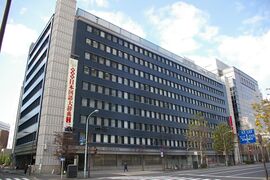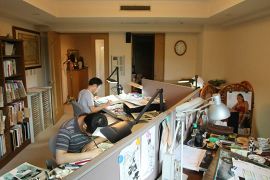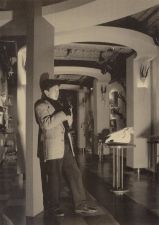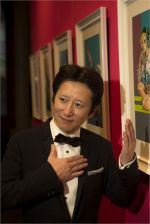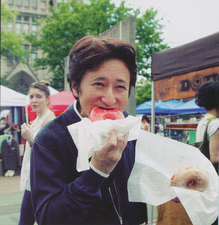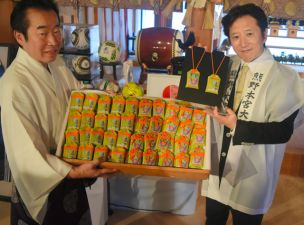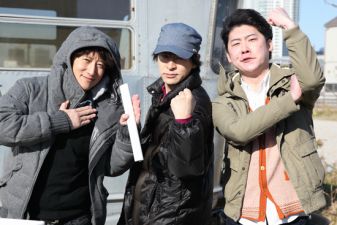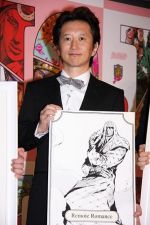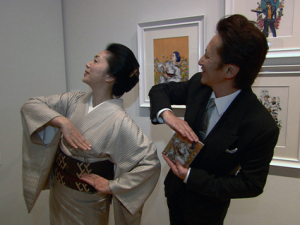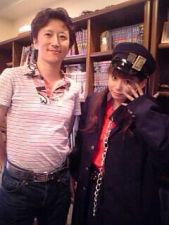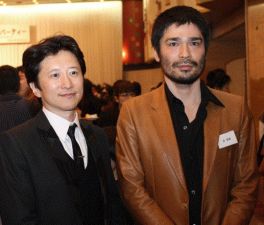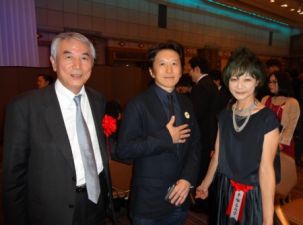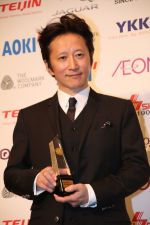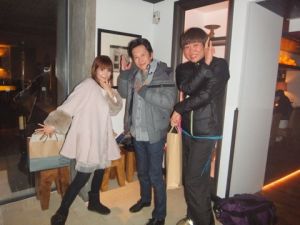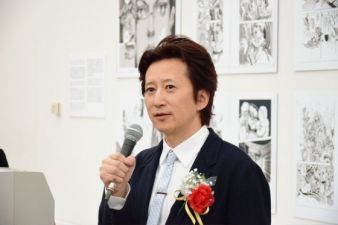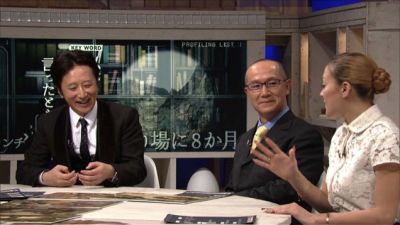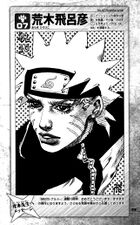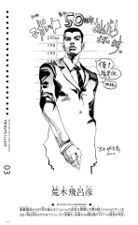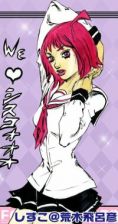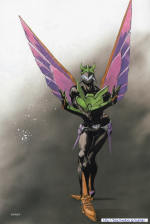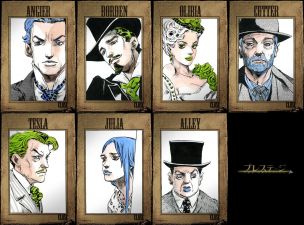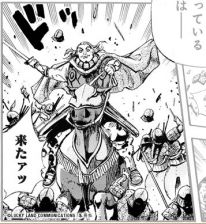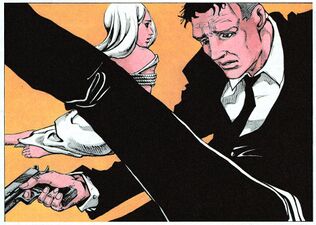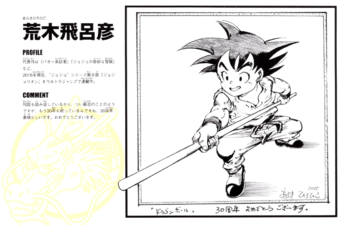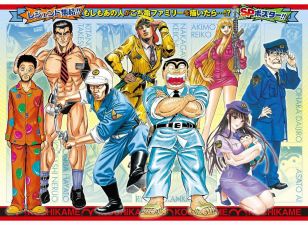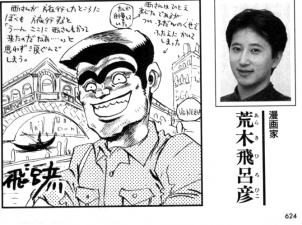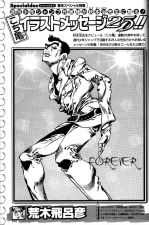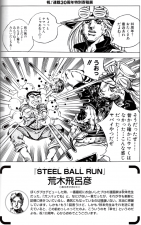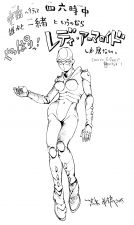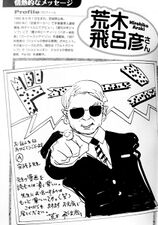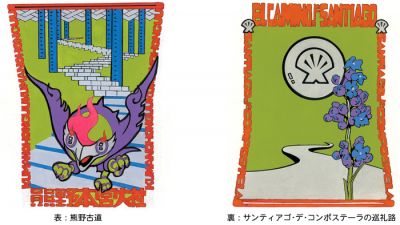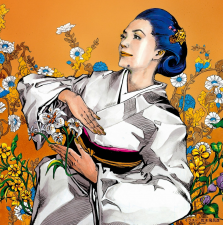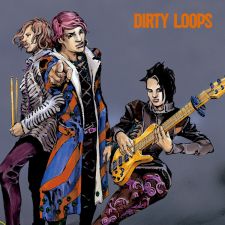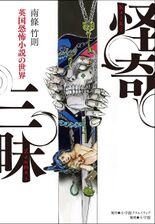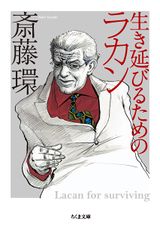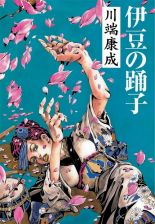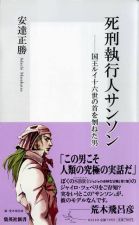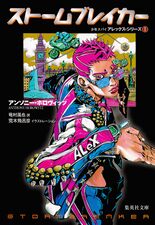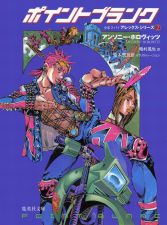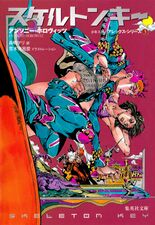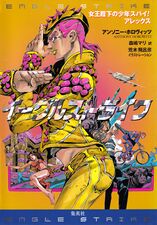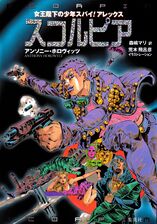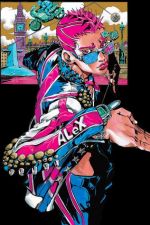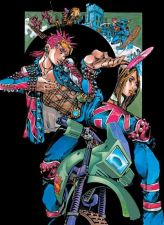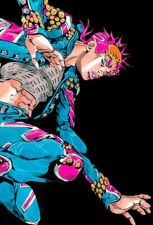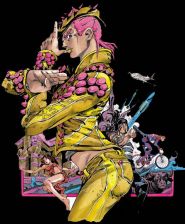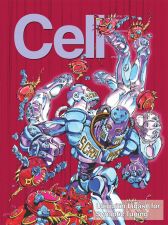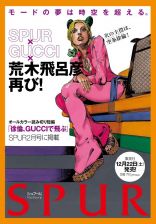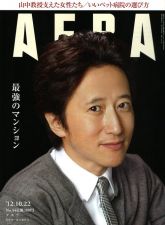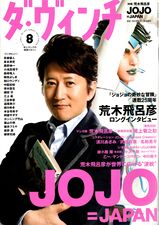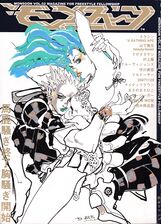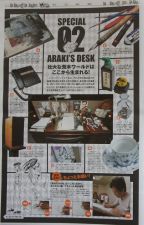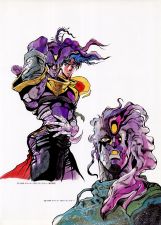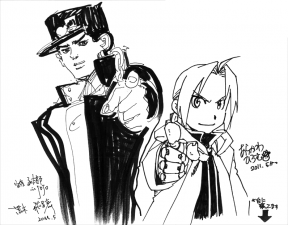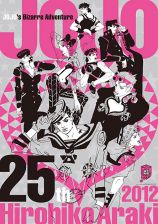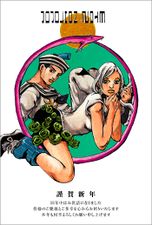Hirohiko Araki
Hirohiko Araki (荒木 飛呂彦, Araki Hirohiko, born June 7, 1960 in Sendai, Miyagi[3]) is a mangaka and author of JoJo's Bizarre Adventure, on which this wikia project is based. He made his debut under the name Toshiyuki Araki (荒木 利之, Araki Toshiyuki) in 1980 with his one-shot Poker Under Arms, and began his professional career with the short series Cool Shock B.T., Baoh, and The Gorgeous Irene.
His work on JoJo's Bizarre Adventure is divided into several parts and continues to be serialized for nearly 30 years, totaling 116 volumes (as of March 2016), circulating over 90 million copies (Sep 2014)[4]. His style has been described as an "experimental, but definitive approach[5][6]."
Works
Manga
- Poker Under Arms (武装ポーカー, Busō Pōkā, 1980)
- Outlaw Man (アウトロー・マン, Autorō Man, 1981)
- Say Hello to Virginia (バージニアによろしく, Bājinia ni Yoroshiku, 1982)
- B.T. "the Wicked Boy" (魔少年ビーティー, Mashōnen Bī Tī, October 23, 1982)
- Cool Shock B.T. (魔少年ビーティー, Mashōnen Bī Tī, September 20, 1983–November 22, 1983)
- Baoh: The Visitor (バオー来訪者, Baō Raihōsha, October 9, 1984 – February 12, 1985)
- Gorgeous Irene (ゴージャス☆アイリン, Gōjasu Airin, 1985–1986)
- JoJo's Bizarre Adventure (December 2, 1986–ongoing)
- The Lives of Eccentrics (変人偏屈列伝, Henjin Henkutsu Retsuden, 1989–2003)
- Under Execution Under Jailbreak (死刑執行中脱獄進行中, Shikei Shikkōchū Datsugoku Shinkōchū, December 28, 1994)
- Dolce and His Master (ドルチ ~ダイ・ハード・ザ・キャット~, Doruchi Dai Hādo Za Kyatto, 1996)
- Thus Spoke Rohan Kishibe (岸辺露伴は動かない, Kishibe Rohan wa Ugokanai, June 24, 1997–December 4, 2015)
- Dead Man's Questions (デッドマンズQ, Deddomanzu Kuesuchonzu, June 2, 1999–July 7, 1999)
- Oingo Boingo Brothers Adventure (オインゴとボインゴ兄弟 大冒険, Oingo to Boingo Kyōdai Daibōken, October 23, 2002)
- Rohan at the Louvre (岸辺露伴 ルーヴルへ行く, Kishibe Rohan Rūvuru e Iku, April 8, 2010)
- Rohan Kishibe Goes to Gucci (岸辺露伴 グッチへ行く, Kishibe Rohan Gutchi e Iku, August 23, 2011)
- Jolyne, Fly High with GUCCI (徐倫、GUCCIで飛ぶ, Jorīn, Gutchi de Tobu, December 22, 2012)
Other
- Famicom Jump II: Saikyo no Shichinin (February 1991, seventh boss monster design)
- Kamedas (1993, an alternate story of Kochira Katsushika-ku Kameari Kōen-mae Hashutsujo, an illustration)
- JoJo's Bizarre Adventure (novel) (November 4, 1993, novel written by Mayori Sekijima and Hiroshi Yamaguchi, illustrated by Araki)
- JoJo 6251 (December 10, 1993, art and guidebook)
- JOJO A-GO!GO! (February 25, 2000, artbook)
- Music is the Key of Life (December 13, 2000, album by Sugiurumn, cover)
- GioGio's Bizarre Adventure 2: Golden Heart, Golden Ring (May 28, 2001, novel written by Gichi Ōtsuka and Tarō Miyashō, supervised and illustrated by Araki)
- Life Ground Music (February 27, 2002, album by Sugiurumn, cover)
- Alex Rider Series (女王陛下の少年スパイ!アレックス) (2002-2007, cover)
- Stormbreaker (novel, illustrations for Fantasy Press)
- Kochira Katsushika-ku Kameari Kōen-mae Hashutsujo (2006, 30th anniversary special illustration)
- "Catwalk" (April 26, 2006, single by SOUL'd OUT, cover)
- Uniqlo (2006, T-shirt design)
- Fist of the North Star (2006, special tribute illustration in Weekly Comic Bunch)
- Cell (September 7, 2007, front cover)
- The Book: JoJo's Bizarre Adventure 4th Another Day (November 26, 2007, novel written by Otsuichi, supervised and illustrated by Arashi)
- The Dancing Girl of Izu (2008, cover)
- "Breeeeze Girl" (June 24, 2009, a single by Base Ball Bear, cover of the limited edition)
- Naruto (2009, 10th anniversary special illustration)
- Hirohiko Araki's Super-Favorites! Rules of Movies (荒木飛呂彦の超偏愛! 映画の掟, "Araki Hirohiko no chō hen'ai! Eiga no okite", May 17, 2011)
- Hirohiko Araki's Bizarre Horror Movie Analysis (荒木飛呂彦の奇妙なホラー映画論, "Araki Hirohiko no Kimyō na Hora Eiga Ron", June 17, 2011)
- Shameless Purple Haze: Purple Haze Feedback (September 16, 2011, novel written by Kouhei Kadono, illustrated by Araki)
- JoJo's Bizarre Adventure Over Heaven (December 16, 2011, novel written by Nisio Isin, cover)
- Jorge Joestar (September 19, 2012, novel written by Ōtarō Maijō, illustrated by Araki)
- X -Cross- (September 19, 2012, an album by Sayuri Ishikawa, cover)
- HIROHIKO ARAKI WORKS 1981-2012 (2012, artbook)
- JOJOmenon (October 5, 2012, artbook)
- JOJOVELLER (September 19, 2013, artbook set)
- JoJonium (December 4, 2013 - March 4, 2015, covers of the large format re-release of JoJo's Bizarre Adventure)
- Main Themes (February 25, 2015, an album by Akira Senju, cover)
- Hirohiko Araki's Manga Technique (荒木飛呂彦の漫画術, "Araki Hirohiko no Manga Jutsu", April 17, 2015)
Personal Life
Araki is often commented on for his unchanging youthful demeanor over the years. He cites training and swimming at the gym and Hitomebore rice as methods for staying fit while over the age of 50[7]. In his 2007 Eureka Interview, he is complimented by Japanese psychologist and critic, Tamaki Saito, but states that the main reason he switched to a monthly serialization was from no longer being able to handle the weekly schedule.[8]
Araki is well known for his position on staying healthy. He enjoys going on walks and riding a bike, particularly to Japanese shrines, and has commended it as his coping mechanism when exhausted from work. He considers exercise as a great way to discipline one's self and that carrying too many things can be a burden; Araki will typically only carry a coat, water, and an Ipod when going out.[9]
This section requires expansion.
Family
Married to Asami Araki (荒木麻美, Araki Asami), Araki is the father of two girls. A couple years after his debut, Araki met Asami in a group meet-up, and the two got married three months later.[10]
Biography
Araki grew up in Sendai, Japan with his parents and younger identical twin sisters. He cites his sisters' annoyances as the reason he spent time alone in his room reading classic manga from the '70s, such as Ai to Makoto, and his father's collection of art books, which Araki assumes informed his motive for drawing manga[11]. He was particularly influenced by the work of French artist Paul Gauguin[12].
Araki drew his very first manga while he was in 4th grade. He attended a prep school through junior high and high school, which was where a friend complimented him on a manga he drew for the first time. Ever since, he began to draw manga in secret of his parents.[11]
He began submitting work to publishers during his first year of high school; however, all of his submissions were rejected[11]. At the same time, others artists who were around his age continued to make big splashes with their debuts (Ex: Yudetamago, Masakazu Katsura). Araki could not understand why he was being rejected, so he decided to finish off a submission on an all-nighter, go on a 4-hour trip to pay a visit to the editors in Tokyo, and ask them for an explanation. At first he intended to visit Shogakukan, which published Shonen Sunday, but he was intimidated by the size of their building, and decided to take his submission into the smaller Shueisha (Publishers of Weekly Shonen Jump) building next door. It was noon when he visited, but one rookie editor (about 6'2", or 185 cm, tall) happened to be there. The editor, after reading the first page, promptly quipped "your white-out's leaked (You haven't fixed it)": he was criticized every time the editor flipped through each page. Araki, exhausted from having been up all night, felt like he was going to pass out, but was told to fix it up for the Tezuka Awards in 5 days. That submission was "Poker Under Arms", which won the runner up prize at the Tezuka Awards.[13][11]
Araki left Miyagi University of Education before graduating, and made his debut in 1980 with the aformentioned one-shot Poker Under Arms. His first serialization in Weekly Shonen Jump was Cool Shock B.T. in 1983[13], with his works Baoh: The Visitor (1984) and Gorgeous Irene (1984) following soon after. His next series would become his magnum opus, 1986's JoJo's Bizarre Adventure.
JoJo's Bizarre Adventure
Published in Weekly Shonen Jump between 1987 and 2004 and from 2004 to the present in Ultra Jump, JoJo's Bizarre Adventure represents Hirohiko Araki's primary brand and body of work.This section requires expansion.
The dust jacket of every volume of JoJo contains a note to the reader; a relatively great source of Araki's direct opinions.
Style and Influences
Araki's drawing commonly involves idealized figures in broad, expressive poses at adventurous scales and angles; with sharply inked lines and scattered, blackened planes; lending them a sculptural effect. In color illustrations and pages, Araki varies roughly complementary color juxtapositions.In terms of cartooning, a comparison can be drawn between Phantom Blood, Battle Tendency and Stardust Crusaders (1987 - '92) and the hypermasculine (and highly dimorphic) anatomical ideals applied by Tetsuo Hara in Fist of the North Star, and referenced by Araki in relation to action heroes of the 1980s.[14] Diamond is Unbreakable ('92 - '96) marks a transition to a more intersexual model; while Steel Ball Run (2004 - '11) sees greater realism, along with further incorporation of ideals of beauty consistent with the mode in fashion design.
Reference to illustrations by artists including Antonio Lopez and Tony Viramontes informs a number of individual illustrations and character poses in Araki's work from 1987 - 1992; decreasing from then along with increased use of photographic references.[15] Limited examples of costumes borrowed from contemporary fashion design have been identified.
As a film fan, In the 1980s Araki noted the popularity of action movies and the muscular physiques characteristic of their stars (such as Arnold Schwarzenegger and Sylvester Stallone). By this example, Araki would ponder; "Who is the strongest person in the world?". Subjects such as immortality and justice occurred to him as things that humans innately value and seek. Araki had also been on a trip to Italy two years prior to the creation of Part I: Phantom Blood, where he identified the exaltation of overt human beauty characteristic of renaissance art. Araki would combine these examples in the formulation of the basic plot and visual style of Phantom Blood.[14]
Araki has named Paul Gauguin and his approach to color theory as an influence.[16]
Araki has described his drawing method as "classical".[14] He has indicated admiration for Leonardo da Vinci in the text of the manga and otherwise; and in a video feature in JOJOVELLER, he is seen making visual reference to a book of Michelangelo's work[17] during the construction of a piece.
Manga that Araki has named as admirable or having had particular influence on him include Ai to Makoto by Ikki Kajiwara and Takumi Nagayasu, the most significant of his youth;[18] Ore wa Teppei by Tetsuya Chiba, which inspired him while in middle school to join the kendo club;[18] and Babel II by Mitsuteru Yokoyama, particularly influential for the concept of combat defined by special rules or laws.[14]
Araki has authored a book on the subject of Horror film and its influence on his work.
Araki has described his habit of naming characters and Stands after musicians and their works as "a simple hobby", and has indicated a strong preference for Western popular music.
Trivia
- Araki's favorite book as a kid was The Adventures of Sherlock Holmes.[2]
- In 2012, Araki celebrated his 30th year as a manga artist and the 25th anniversary of JoJo’s Bizarre Adventure. A special exibiton was held in Sendai, Japan, which included the announcement for the TV Anime and All-Star Battle.
- In November 30 2016, Araki won the 45th Annual Best Dresser Awards in Tokyo in the "Academic and Cultural Arts" division. When questioned about his youthful appearance, the 56 year old mangaka revealed that he washes his face every morning with Tokyo's tap water."[19]
Gallery
Artist Photos
Tributes
Album Covers
Novels
Magazines
Other
External links
| This page uses Creative Commons Licensed content from Wikipedia (view authors). |
- Tokai High School lecture, 2006, translated by Neuroretardant for ComiPress
References
|
